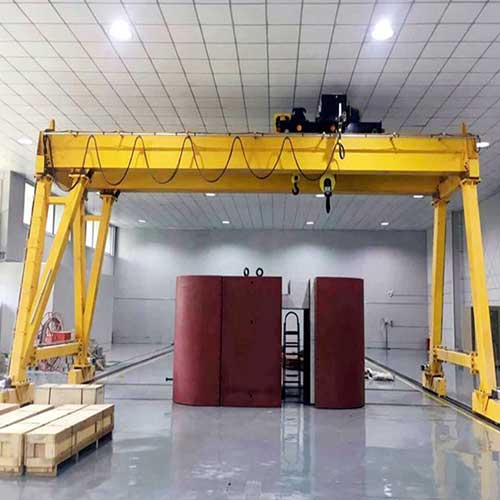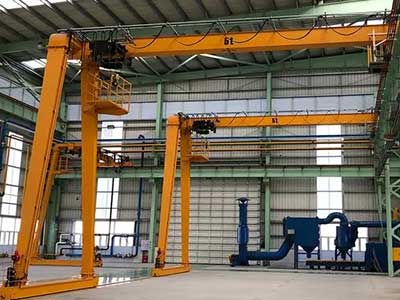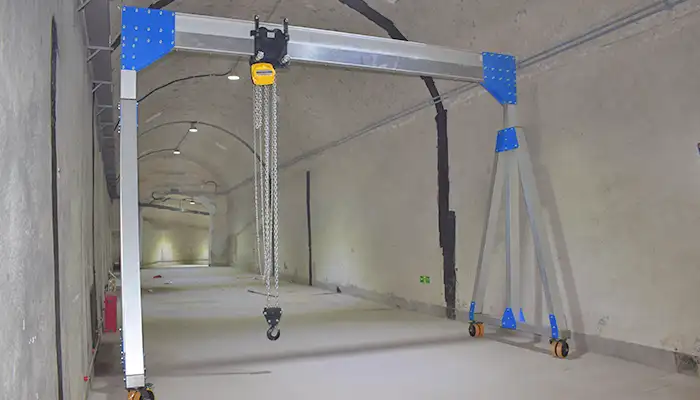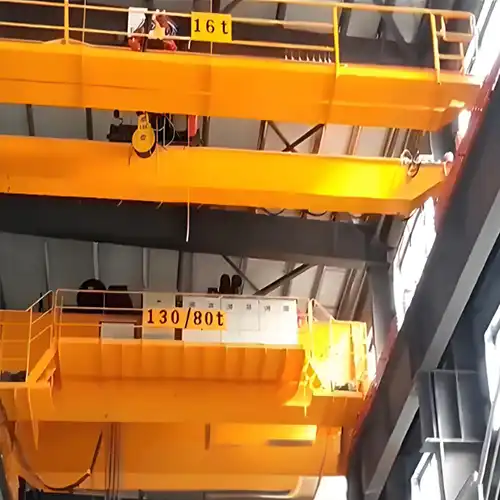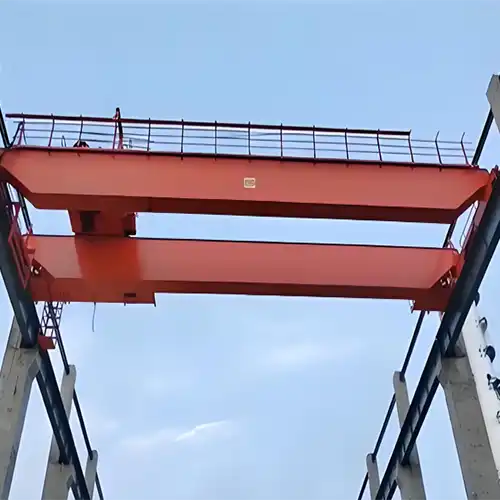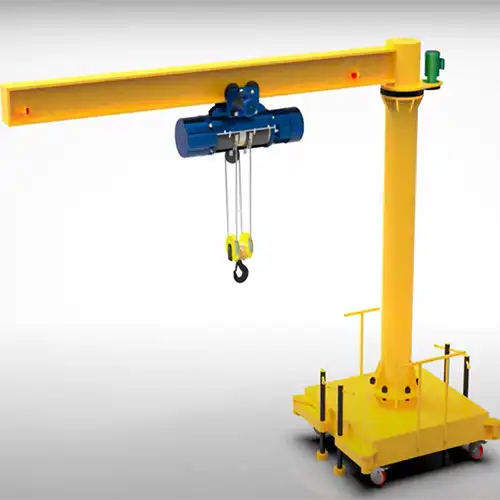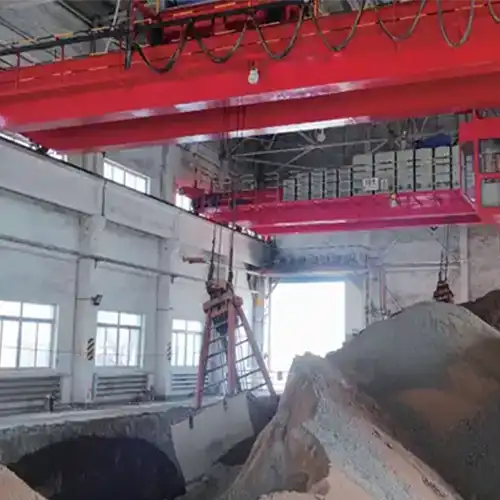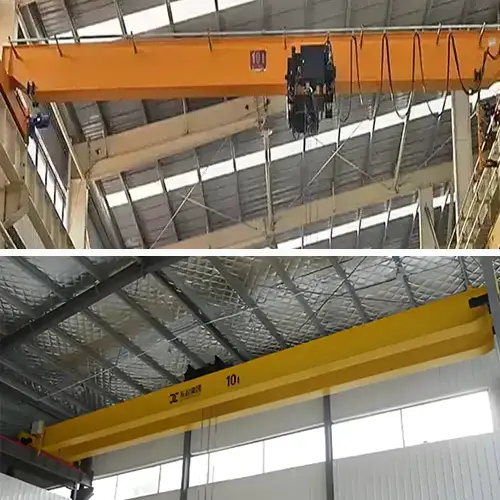Indoor Gantry Crane System: Types of Indoor Gantries Comparisons
Indoor gantry crane for sale. Types of indoor gantry cranes, single & double girder, goliath gantry & small portable gantry, semi gantry crane.Check now.
Category: Indoor Crane
Your Trusted Indoor Crane Manufacturer & Supplier
Indoor Gantry Crane System: Types of Indoor Gantry CraneComparisons
Indoor Gantry Cranes: Efficiency in Your Workspace
In the fast-paced world of industry and manufacturing, efficiency is often the name of the game. Companies are continually seeking ways to streamline their operations and optimize productivity. This is where indoor gantry cranes step in. These powerful pieces of machinery are essential in a variety of sectors, revolutionizing the way materials are handled, and enhancing overall efficiency.
Indoor gantry cranes, also known as overhead cranes, are heavy-duty lifting equipment designed to move materials within a fixed workspace. They consist of a bridge-like structure with a hoist that moves along it. The primary purpose of these cranes is to lift and transport heavy loads with precision and safety. They play a pivotal role in various industries, from manufacturing and warehousing to construction and logistics.
The significance of indoor gantry cranes in modern industries cannot be overstated. They have become the backbone of material handling, enabling companies to achieve a high level of efficiency. These cranes are versatile and find applications in industries such as automotive manufacturing, steel production, aerospace, and more. The ability to move and position heavy materials and components swiftly is a key advantage for these sectors.
Unveiling the Potential of Indoor Gantry Cranes
Overview of Indoor Gantry Cranes
An indoor gantry crane is a versatile lifting and material handling equipment designed for use within enclosed workspaces. These cranes are characterized by their robust structure, which typically consists of one or two horizontal beams (single or double girder) that support a hoist and trolley mechanism.
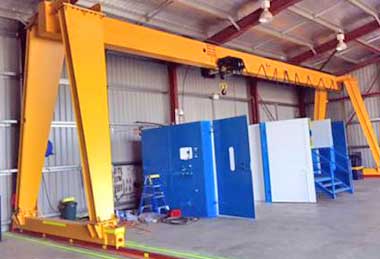
single girder indoor gantry crane for sale

double girder indoog gantry crane for sale

single girder indoor gantry crane for sale

Double girder indoor gantry crane for sale
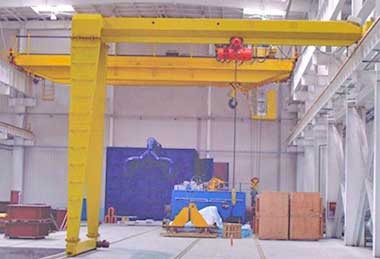
single leg indoor gantry crane for sale

Small portable gantry crane for sale

Aluminum indoor gantry crane for sale

Adjustable height indoor gantry crane for sale
Indoor gantry cranes come in various designs, with the most common being the single-leg and double-leg gantry cranes. They are designed to accommodate different weight capacities, ranging from a few tons to several hundred tons. Depending on the requirements of a particular industry, these cranes can be customized to meet the specific needs of the workspace.
Keywords:
- 1. Lifting Equipment: Gantry cranes are essential for lifting heavy loads, machinery, and materials within industrial and warehouse settings.
- 2. Material Handling: They streamline material handling processes by providing precision and efficiency in load transportation.
- 3. Indoor Usage: Indoor gantry cranes are designed specifically for use within indoor facilities, where they maximize space utilization and enhance workflow.
- 4. Versatility: These cranes are versatile, capable of handling various load types and sizes, making them essential in a wide range of industries.
- 5. Precision: Gantry cranes offer precision in load positioning, contributing to safety and quality in material handling.
- 6. Safety Features: They are equipped with safety features, including overload protection and emergency stop functions, to ensure safe operations.
- 7. Maintenance: Regular maintenance is crucial to keep these cranes in optimal condition and extend their operational life.
- 8. Cost-Efficiency: Gantry cranes reduce labor costs, enhance productivity, and optimize space, leading to cost savings for businesses.
- 9. Manufacturing Excellence: In manufacturing, they play a pivotal role in achieving excellence by ensuring accurate and safe handling of heavy machinery and components.
- 10. Space Utilization: Gantry cranes maximize vertical space utilization, making them suitable for warehouses and facilities with limited floor space.
- 11. Future Trends: Anticipated future developments include smart technology integration, energy efficiency, customization options, and integration with automation.
In summary, indoor gantry cranes are integral to various industries, facilitating the efficient movement of heavy loads in enclosed workspaces while emphasizing precision, safety, and space optimization. Their continued evolution and integration with advanced technologies make them a crucial part of workspace efficiency in the modern industrial landscape.
Advantages of Using Indoor Gantry Cranes
One of the primary advantages of indoor gantry cranes is their ability to significantly reduce manual labor and handling costs. They are known for their precision and safety in handling heavy loads, minimizing the risk of accidents and damage to materials. These cranes also maximize space utilization, making them ideal for operations where space is limited. They are highly efficient, ensuring that materials are transported quickly and accurately, contributing to enhanced productivity.
Typical Applications and Industries They Serve
Indoor gantry cranes are incredibly versatile and serve a wide range of applications. In manufacturing, they play a vital role in moving heavy machinery and components, facilitating precision assembly and streamlining production processes. In warehousing, they are indispensable for optimizing space and efficiently handling materials, ultimately reducing storage and operational costs. From shipyards to construction sites, these cranes are indispensable in various industries that require heavy lifting and precise positioning.
As we delve deeper into the world of indoor gantry cranes, we will explore their different types, their impact on warehouse operations, their role in achieving manufacturing excellence, their environmental benefits, and key maintenance tips to keep them running efficiently. Stay tuned to discover how these machines can revolutionize your workspace.
Single Leg vs. Double Leg Indoor Gantry Cranes: Which Is Right for You?
When considering the implementation of indoor gantry cranes in your workspace, one of the first decisions you'll encounter is whether to opt for a single leg or a double leg gantry crane. Understanding the design differences and making an informed choice is crucial for optimizing your material handling operations.
Understanding the Design Differences
Single leg and double leg gantry cranes differ primarily in their structural design. Let's take a closer look at the key design disparities:
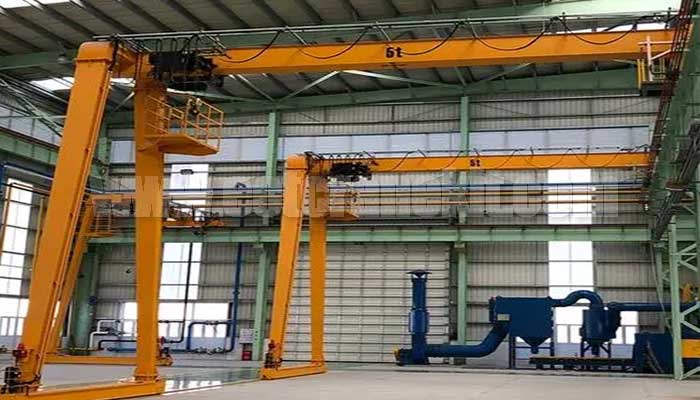
Single Leg Indoor Gantry Cranes:
- Structure: These cranes have a single supporting leg on one side and a horizontal beam extending from the other side.
- Support: They are supported by the building's existing structure, making them suitable for spaces with limited floor space.
- Cost-Efficiency: Typically, single leg cranes are more cost-effective to install and maintain.
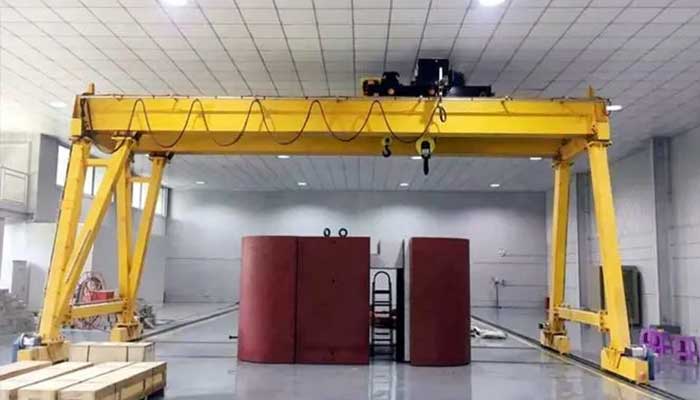
Double Leg Indoor Gantry Cranes:
- Structure: These cranes have two vertical legs, one on each side of the bridge beam.
- Independence: They are freestanding and do not rely on the building's structure for support.
- Stability: Double leg gantry cranes are known for their stability and can accommodate heavier loads compared to single leg cranes.
Comparative Analysis of Single Leg and Double Leg Gantry Cranes
To determine which type of gantry crane is suitable for your workspace, consider the following comparative factors:
- 1. Load Capacity: Double leg cranes are generally capable of lifting heavier loads than their single leg counterparts, making them ideal for heavy-duty applications.
- 2. Space Availability: Single leg cranes are a better choice when space is limited because they require less floor space.
- 3. Cost: Single leg cranes are often more cost-effective to install due to their reduced structural requirements. However, long-term maintenance costs may vary.
- 4. Flexibility: Double leg cranes offer greater flexibility in terms of positioning and movement, while single leg cranes are more static in their setup.
Factors to Consider When Choosing Between the Two
When deciding between single leg and double leg gantry cranes, consider the specific needs of your workspace and operations:
- 1. Weight of Loads: If your operations involve consistently handling heavy loads, a double leg gantry crane may be the better choice.
- 2. Available Space: Assess the available floor space in your facility. If space is limited, a single leg crane might be more practical.
- 3. Budget: Consider your budget, including initial installation costs and long-term maintenance expenses.
- 4. Application: Think about the type of work your gantry crane will be performing. Will it require frequent repositioning or mostly stationary lifting?
- 5. Future Growth: Anticipate any future expansion or changes in your operations that may impact your gantry crane requirements.
In conclusion, the choice between single leg and double leg gantry cranes should be based on a comprehensive evaluation of your specific needs. Each type has its own advantages, and selecting the right one will ultimately contribute to the efficiency of your workspace. The decision you make will have a significant impact on your material handling operations, so choose wisely.
Let's check the table which highlight the key differences and similarities between single leg and double leg indoor gantry cranes.
| Aspect | Single Leg Gantry Crane | Double Leg Gantry Crane |
|---|---|---|
| Structural Design | One supporting leg on one side, horizontal beam on the other side. | Two vertical legs, one on each side of the bridge beam. |
| Support | Supported by the building's existing structure. | Freestanding and does not rely on the building's structure for support. |
| Load Capacity | Generally suitable for lighter to moderate loads. | Capable of handling heavier loads, suitable for heavy-duty applications. |
| Space Requirements | Requires less floor space, making them suitable for spaces with limited floor space. | Requires more floor space due to the presence of two vertical legs. |
| Cost-Efficiency | Often more cost-effective to install. | Initial installation costs may be higher due to structural requirements. |
| Flexibility | Limited flexibility, more static in setup. | Greater flexibility in positioning and movement. |
| Stability | Less stable for very heavy loads. | Highly stable, making them ideal for heavy loads. |
Similarities:
- Both types of gantry cranes serve the primary purpose of lifting and transporting heavy loads within a fixed workspace.
- They are essential in material handling operations and contribute to increased efficiency in various industries.
- Maintenance and safety considerations apply to both single leg and double leg gantry cranes.
Differences:
- Structural Design: Single leg cranes have one supporting leg, while double leg cranes have two vertical legs.
- Support: Single leg cranes rely on the building's existing structure for support, whereas double leg cranes are freestanding.
- Load Capacity: Single leg cranes are typically designed for lighter to moderate loads, while double leg cranes can handle heavier loads, making them suitable for heavy-duty applications.
- Space Requirements: Single leg cranes require less floor space, which is advantageous in facilities with limited space. Double leg cranes require more floor space due to their two vertical legs.
- Cost-Efficiency: Single leg cranes are generally more cost-effective for installation, whereas double leg cranes may have higher initial installation costs due to their structural requirements.
- Flexibility: Single leg cranes offer limited flexibility and are more static in their setup, while double leg cranes provide greater flexibility in positioning and movement.
- Stability: Double leg cranes are known for their stability, making them ideal for very heavy loads, while single leg cranes may be less stable in such scenarios.
The choice between single leg and double leg gantry cranes should be based on your specific operational needs and constraints, taking these differences and similarities into account.
Single Girder vs. Double Girder Indoor Gantry Cranes: Which Is Right for You?
In the world of indoor gantry cranes, another critical choice you'll face is whether to opt for a single girder or a double girder gantry crane. Understanding the design differences, conducting a comparative analysis, and considering the relevant factors will help you make an informed choice tailored to your specific needs.
A. Understanding the Design Differences
Single girder and double girder gantry cranes differ primarily in their design configurations, which have a significant impact on their capabilities and applications. Here's a closer look at their design disparities:

Single Girder Indoor Gantry Cranes with Low headroom Design - Low headroom Crane for Low Built Facility
- Structure: These cranes feature a single horizontal girder or beam to support the hoist and trolley mechanism.
- Lighter Loads: Typically designed for handling lighter to moderate loads.
- Space Efficiency: Well-suited for operations where vertical space is limited because of their compact design.
- Cost-Efficiency: Generally more cost-effective in terms of initial installation and maintenance.

Double Girder Goliath Gantry Cranes for Sale
- Structure: These cranes have two horizontal girders or beams for added support and stability.
- Heavier Loads: Designed to handle heavier loads and are well-suited for heavy-duty applications.
- Height and Span: Offer a more extensive vertical lift and span capability.
- Durability: Known for their robust construction and durability, making them suitable for demanding industrial settings.
Comparative Analysis of Single Girder vs. Double Girder Gantry Cranes
To determine which type of gantry crane is the right fit for your workspace, consider the following comparative factors:
- 1. Load Capacity: Double girder cranes can handle significantly heavier loads compared to single girder cranes.
- 2. Vertical Space: Single girder cranes are more space-efficient vertically, while double girder cranes provide a larger vertical working space.
- 3. Span: Double girder cranes offer a more extensive span, making them ideal for covering larger areas.
- 4. Cost: Single girder cranes are often more cost-effective in terms of initial installation and maintenance costs.
- 5. Maintenance: Single girder cranes may require less maintenance due to their simpler design.
Factors to Consider When Choosing Between the Two
When deciding between single girder and double girder gantry cranes, consider the specific needs of your workspace and operations:
- 1. Weight of Loads: If your operations involve consistently handling heavy loads, a double girder gantry crane is likely the better choice.
- 2. Vertical Space: Assess the available vertical space in your facility. If vertical space is limited, a single girder crane might be more practical.
- 3. Span Requirements: Consider the horizontal span required to cover your workspace efficiently. Double girder cranes are better suited for larger spans.
- 4. Budget: Think about your budget, taking into account both initial installation costs and long-term maintenance expenses.
- 5. Application: Consider the type of work your gantry crane will be performing. Will it involve primarily light to moderate loads or very heavy loads?
- 6. Durability: Assess the durability requirements of your operations. Heavy-duty applications often benefit from the robust construction of double girder cranes.
In conclusion, the choice between single girder and double girder gantry cranes should be based on a comprehensive evaluation of your specific needs and operational constraints. Each type has its advantages, and the decision you make will significantly impact the efficiency of your material handling operations. Choose wisely to optimize your workspace.
Let's check the table which highlight to summarize the key similarities and differences between single girder and double girder indoor gantry cranes:
| Aspect | Single Girder Gantry Crane | Double Girder Gantry Crane |
|---|---|---|
| Structural Design | Single horizontal girder or beam to support the hoist and trolley mechanism. | Two horizontal girders or beams for added support and stability. |
| Load Capacity | Typically designed for handling lighter to moderate loads. | Designed to handle heavier loads, suitable for heavy-duty applications. |
| Vertical Space Efficiency | Space-efficient vertically, making them suitable for areas with limited vertical clearance. | Provide a larger vertical working space, ideal for operations with ample vertical space. |
| Horizontal Span Capability | Suitable for covering smaller spans. | Ideal for covering larger spans efficiently. |
| Cost-Efficiency | Generally more cost-effective in terms of initial installation and maintenance costs. | May have higher initial installation costs due to their more substantial construction. |
| Maintenance Requirements | May require less maintenance due to their simpler design. | May have slightly higher maintenance requirements due to their heavier-duty nature. |
Similarities:
- Material Handling: Both single girder and double girder gantry cranes serve the primary purpose of lifting and transporting heavy loads within a fixed workspace.
- Efficiency: They enhance workspace efficiency by streamlining material handling and improving productivity.
- Safety: Maintenance and safety considerations apply to both types to ensure safe and reliable operation.
Differences:
- Structural Design: Single girder cranes have one horizontal girder, while double girder cranes have two, providing added stability for heavier loads.
- Load Capacity: Single girder cranes are designed for lighter to moderate loads, whereas double girder cranes can handle significantly heavier loads, making them ideal for heavy-duty applications.
- Vertical Space Efficiency: Single girder cranes are space-efficient vertically, suitable for operations with limited vertical clearance, while double girder cranes provide a more extensive vertical working space.
- Horizontal Span Capability: Single girder cranes are ideal for covering smaller spans, while double girder cranes are well-suited for larger spans.
- Cost-Efficiency: Single girder cranes are generally more cost-effective in terms of initial installation and maintenance costs, while double girder cranes may have higher initial installation costs due to their more substantial construction.
- Maintenance Requirements: Single girder cranes may require less maintenance due to their simpler design, while double girder cranes may have slightly higher maintenance requirements due to their heavier-duty nature.
The choice between a single girder and a double girder gantry crane should be made based on your specific operational requirements and constraints, considering these differences and similarities to optimize your material handling operations effectively.
Rail Travelling vs. Wheel or Castor Travelling Indoor Gantry Cranes: Which Is Right for You?
In the realm of indoor gantry cranes, the choice between rail-travelling and wheel or castor-travelling gantry cranes is a pivotal decision. To make an informed choice, it's crucial to understand the design differences, conduct a comparative analysis, and consider the relevant factors.
Understanding the Design Differences
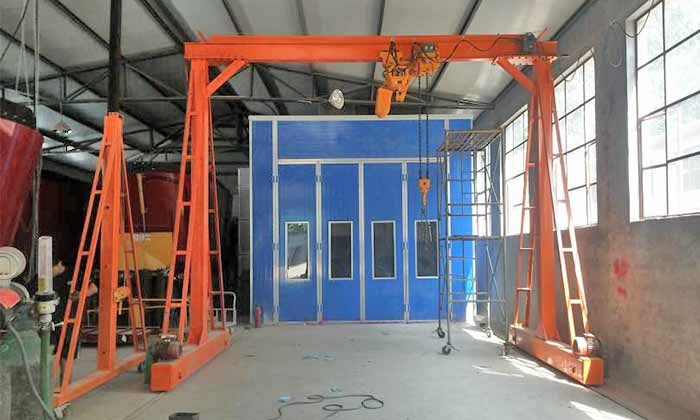
Rail-Travelling Gantry Cranes:
- Mobility: These cranes move along a set of fixed rails or tracks installed on the floor, offering a guided and predictable path.
- Stability: They are highly stable and suitable for applications where precise positioning is critical.
- Floor Requirements: Require a level and smooth floor surface to function optimally.
- Maintenance: Generally, they have lower maintenance requirements as they experience less wear and tear on their mobility components.

Wheel or Castor-Travelling Gantry Cranes:
- Mobility: These cranes use wheels or castors to move freely on the floor without the need for fixed tracks.
- Flexibility: Offer greater flexibility in terms of movement, as they are not restricted to a fixed path.
- Floor Requirements: More adaptable to uneven or less smooth floor surfaces, making them suitable for a variety of environments.
- Maintenance: May have slightly higher maintenance requirements due to the wear and tear on their mobility components.
Comparative Analysis of Rail Travelling vs. Wheel or Castor Travelling Gantry Cranes
To determine which type of gantry crane is right for your workspace, consider the following comparative factors:
- 1. Mobility: Rail-travelling gantry cranes offer predictable and guided movement, while wheel or castor-travelling cranes provide more freedom and flexibility in movement.
- 2. Stability: Rail-travelling cranes are more stable, making them ideal for applications requiring precise positioning, while wheel or castor-travelling cranes may be more versatile but slightly less stable.
- 3. Floor Requirements: Rail-travelling cranes require a level and smooth floor surface, whereas wheel or castor-travelling cranes are adaptable to uneven or less smooth floors.
- 4. Maintenance: Rail-travelling cranes typically have lower maintenance requirements due to less wear and tear on their mobility components. Wheel or castor-travelling cranes may require more maintenance in this regard.
Factors to Consider When Choosing Between the Two
When deciding between rail-travelling and wheel or castor-travelling gantry cranes, consider the specific needs of your workspace and operations:
- 1. Precision vs. Flexibility: If your operations require precise and predictable movement, rail-travelling gantry cranes are the better choice. For more flexible and adaptable movement, wheel or castor-travelling gantry cranes are preferred.
- 2. Floor Condition: Assess the condition of your floor. If it's level and smooth, rail-travelling cranes are suitable. If the floor is uneven or rough, wheel or castor-travelling cranes may be a better fit.
- 3. Maintenance: Consider your maintenance capacity and budget. Rail-travelling cranes generally have lower maintenance requirements, while wheel or castor-travelling cranes may require more attention to mobility components.
- 4. Operational Needs: Think about the type of work your gantry crane will be performing. Is precise and stable positioning required, or do you need more freedom and adaptability in movement?
In conclusion, the choice between rail-travelling and wheel or castor-travelling gantry cranes should be based on a comprehensive evaluation of your specific operational requirements. Each type has its advantages, and the decision you make will significantly impact the efficiency of your material handling operations. Choose wisely to optimize your workspace.
Let's check the table which highlight summarizing the key similarities and differences between rail-travelling and wheel or castor-travelling indoor gantry cranes:
| Aspect | Rail-Travelling Gantry Crane | Wheel or Castor-Travelling Gantry Crane |
|---|---|---|
| Mobility | Moves along fixed rails or tracks, offering guided and predictable movement. | Uses wheels or castors for more flexible and free movement on the floor. |
| Stability | Highly stable, suitable for applications requiring precise positioning. | Offers flexibility in movement but may be slightly less stable. |
| Floor Requirements | Requires a level and smooth floor surface for optimal operation. | More adaptable to uneven or less smooth floor surfaces. |
| Maintenance | Typically has lower maintenance requirements due to less wear and tear on mobility components. | May require more maintenance due to increased wear and tear on mobility components. |
Similarities:
- Material Handling: Both types of gantry cranes serve the primary purpose of lifting and transporting heavy loads within a fixed workspace.
- Efficiency: They enhance workspace efficiency by streamlining material handling and improving productivity.
- Safety: Maintenance and safety considerations apply to both types to ensure safe and reliable operation.
The choice between rail-travelling and wheel or castor-travelling gantry cranes should be made based on your specific operational requirements and constraints, considering these differences and similarities to optimize your material handling operations effectively.
Differences:
- 1. Mobility: Rail-travelling gantry cranes move along a set of fixed rails or tracks, offering a guided and predictable path, whereas wheel or castor-travelling cranes use wheels or castors to move freely on the floor without the need for fixed tracks, providing more freedom and flexibility in movement.
- 2. Stability: Rail-travelling cranes are more stable, making them ideal for applications requiring precise positioning, while wheel or castor-travelling cranes offer flexibility but may be slightly less stable.
- 3. Floor Requirements: Rail-travelling cranes require a level and smooth floor surface to function optimally, whereas wheel or castor-travelling cranes are more adaptable to uneven or less smooth floors.
- 4. Maintenance: Rail-travelling cranes typically have lower maintenance requirements as they experience less wear and tear on their mobility components, while wheel or castor-travelling cranes may require more maintenance in this regard due to the mobility components experiencing more wear and tear.
The choice between rail-travelling and wheel or castor-travelling gantry cranes should be made based on your specific operational requirements and constraints, considering these differences and similarities to optimize your material handling operations effectively.
Streamlining Warehouse Operations with Indoor Gantry Cranes
Efficiency in warehouse operations is a critical aspect for businesses to remain competitive. Indoor gantry cranes play a pivotal role in achieving this goal. In this section, we will explore how these cranes enhance warehouse operations by improving material handling efficiency, reducing labor and handling costs, maximizing space utilization, and share some case studies demonstrating the positive impact on warehouses.
Enhancing Material Handling Efficiency
Indoor gantry cranes are precision instruments designed to lift and transport heavy loads with accuracy and reliability. This capability results in enhanced material handling efficiency within warehouses. Here are some key points to consider:
- 1. Speed and Precision: Gantry cranes can swiftly and accurately move loads to the desired location, reducing handling time and minimizing errors.
- 2. Reduced Downtime: Their consistent performance reduces downtime, ensuring that materials are readily available when needed.
- 3. Versatility: Gantry cranes can handle various types of loads, from machinery and equipment to raw materials, providing versatile solutions for different warehouse needs.
Reducing Labor and Handling Costs
Labor and handling costs can be substantial in warehouse operations. Gantry cranes contribute to cost reduction in the following ways:
- 1. Labor Efficiency: By automating the lifting and transporting process, gantry cranes reduce the need for manual labor, leading to significant cost savings.
- 2. Minimized Workforce Fatigue: Handling heavy loads manually can lead to worker fatigue and potential injuries. Gantry cranes mitigate this risk, reducing associated costs.
- 3. Faster Throughput: With faster and more efficient material handling, warehouses can process more orders in less time, resulting in cost savings.
Maximizing Space Utilization in Warehouses
Space utilization is a critical factor in warehouse management. Gantry cranes optimize space in several ways:
- 1. Vertical Space Utilization: Gantry cranes can reach and transport loads vertically, making use of the often-underutilized vertical space in warehouses.
- 2. Reduced Aisle Width Requirements: Gantry cranes require less aisle space compared to forklifts or other manual handling methods, allowing for more storage space.
- 3. Configurability: Gantry cranes are adaptable to different warehouse layouts, allowing for efficient use of available space.
Case Studies on Improved Warehouse Operations
Real-world case studies can vividly illustrate the positive impact of gantry cranes on warehouse operations. Here are a few examples:
- 1. Automated Pallet Handling: A warehouse implemented gantry cranes for automated pallet handling. This reduced labor costs, improved accuracy, and increased throughput by 30%.
- 2. Aerospace Components Storage: In an aerospace parts warehouse, gantry cranes increased storage density by utilizing vertical space efficiently, allowing for the storage of more components in the same area.
- 3. Manufacturing Supply Chain: A manufacturing facility improved its supply chain by integrating gantry cranes, ensuring just-in-time delivery of materials and reducing overall production time.
In conclusion, indoor gantry cranes are essential tools for streamlining warehouse operations. They enhance material handling efficiency, reduce labor and handling costs, and maximize space utilization. These benefits, as demonstrated by real-world case studies, make gantry cranes a valuable asset for warehouses aiming to improve their overall efficiency and competitiveness.
The Role of Indoor Gantry Cranes in Manufacturing Excellence
Indoor gantry cranes play a significant role in elevating manufacturing operations to a level of excellence. They contribute to precision, safety, and the efficient handling of heavy machinery and components. Moreover, they enable just-in-time manufacturing, ultimately enhancing productivity and output. In this section, we'll delve into the critical role gantry cranes play in achieving manufacturing excellence.
Precision and Safety in Manufacturing
- 1. Accurate Positioning: Gantry cranes ensure precise positioning of heavy machinery and components. This accuracy is crucial in manufacturing processes where even minor misalignments can lead to defects or rework.
- 2. Enhanced Safety: Gantry cranes are equipped with safety features like overload protection and emergency stop functions, minimizing the risk of accidents and injuries in manufacturing facilities.
- 3. Reduced Human Error: By automating lifting and transportation tasks, gantry cranes reduce reliance on manual labor, minimizing the risk of human error in handling materials and components.
Handling Heavy Machinery and Components
- 1. Heavy Load Capacity: Gantry cranes are designed to handle heavy loads with ease, making them indispensable for lifting and transporting heavy machinery and components used in manufacturing.
- 2. Versatility: They can adapt to a variety of manufacturing needs, from moving large molds and dies in the automotive industry to positioning heavy components in aerospace manufacturing.
- 3. Reduced Wear and Tear: By taking on the burden of handling heavy loads, gantry cranes extend the lifespan of equipment and reduce maintenance costs.
Just-In-Time Manufacturing Benefits
- 1. Efficient Material Flow: Gantry cranes support the principles of just-in-time manufacturing by facilitating the efficient flow of materials to the production line. This minimizes the need for extensive warehousing.
- 2. Reduced Inventory Costs: With materials arriving just in time for production, inventory holding costs are reduced, and manufacturers can operate with leaner, more cost-effective processes.
- 3. Optimized Production: Just-in-time manufacturing supported by gantry cranes results in optimal production schedules, reducing lead times and increasing overall efficiency.
Improved Productivity and Output
- 1. Enhanced Workflow: Gantry cranes accelerate the production process by efficiently moving materials and equipment to the right place at the right time.
- 2. Reduced Downtime: The ability to swiftly position machinery and components minimizes downtime, ensuring that manufacturing processes continue without interruption.
- 3. Increased Output: Gantry cranes contribute to increased productivity, allowing manufacturers to meet demand more effectively and boost their output.
In conclusion, indoor gantry cranes are essential tools for achieving manufacturing excellence. They bring precision, safety, and efficiency to manufacturing operations by handling heavy machinery and components, supporting just-in-time manufacturing, and ultimately improving productivity and output. Their role in manufacturing is pivotal, ensuring that products are made with the highest quality and efficiency, driving businesses toward excellence in their respective industries.
The Role of Indoor Gantry Cranes in Manufacturing Excellence
Indoor gantry cranes play a significant role in elevating manufacturing operations to a level of excellence. They contribute to precision, safety, and the efficient handling of heavy machinery and components. Moreover, they enable just-in-time manufacturing, ultimately enhancing productivity and output. In this section, we'll delve into the critical role gantry cranes play in achieving manufacturing excellence.
Precision and Safety in Manufacturing
- 1. Accurate Positioning: Gantry cranes ensure precise positioning of heavy machinery and components. This accuracy is crucial in manufacturing processes where even minor misalignments can lead to defects or rework.
- 2. Enhanced Safety: Gantry cranes are equipped with safety features like overload protection and emergency stop functions, minimizing the risk of accidents and injuries in manufacturing facilities.
- 3. Reduced Human Error: By automating lifting and transportation tasks, gantry cranes reduce reliance on manual labor, minimizing the risk of human error in handling materials and components.
Handling Heavy Machinery and Components
- 1. Heavy Load Capacity: Gantry cranes are designed to handle heavy loads with ease, making them indispensable for lifting and transporting heavy machinery and components used in manufacturing.
- 2. Versatility: They can adapt to a variety of manufacturing needs, from moving large molds and dies in the automotive industry to positioning heavy components in aerospace manufacturing.
- 3. Reduced Wear and Tear: By taking on the burden of handling heavy loads, gantry cranes extend the lifespan of equipment and reduce maintenance costs.
Just-In-Time Manufacturing Benefits
- 1. Efficient Material Flow: Gantry cranes support the principles of just-in-time manufacturing by facilitating the efficient flow of materials to the production line. This minimizes the need for extensive warehousing.
- 2. Reduced Inventory Costs: With materials arriving just in time for production, inventory holding costs are reduced, and manufacturers can operate with leaner, more cost-effective processes.
- 3. Optimized Production: Just-in-time manufacturing supported by gantry cranes results in optimal production schedules, reducing lead times and increasing overall efficiency.
Improved Productivity and Output
- 1. Enhanced Workflow: Gantry cranes accelerate the production process by efficiently moving materials and equipment to the right place at the right time.
- 2. Reduced Downtime: The ability to swiftly position machinery and components minimizes downtime, ensuring that manufacturing processes continue without interruption.
- 3. Increased Output: Gantry cranes contribute to increased productivity, allowing manufacturers to meet demand more effectively and boost their output.
In conclusion, indoor gantry cranes are essential tools for achieving manufacturing excellence. They bring precision, safety, and efficiency to manufacturing operations by handling heavy machinery and components, supporting just-in-time manufacturing, and ultimately improving productivity and output. Their role in manufacturing is pivotal, ensuring that products are made with the highest quality and efficiency, driving businesses toward excellence in their respective industries.
Key Maintenance Tips for Indoor Gantry Cranes
Maintaining indoor gantry cranes is essential to ensure their safe and efficient operation. In this section, we'll explore key maintenance tips for these cranes, including regular inspections and lubrication, preventive maintenance practices, common maintenance challenges, and the role of professional maintenance services.
Regular Inspection and Lubrication
- 1. Routine Visual Checks: Regularly inspect the crane for signs of wear, damage, or misalignment. Pay close attention to cables, hooks, and the structure itself.
- 2. Lubrication: Ensure all moving parts are well-lubricated to reduce friction and wear. Lubrication extends the crane's lifespan and prevents breakdowns.
- 3. Electrical Components: Inspect electrical systems, including switches, controls, and wiring, to ensure they are in good condition and functioning correctly.
- 4. Safety Features: Test and verify the proper functioning of safety features, such as overload protection and emergency stop functions.
Preventive Maintenance Practices
- 1. Regular Maintenance Schedule: Create and adhere to a maintenance schedule that includes routine checks, lubrication, and preventive tasks.
- 2. Replacement of Worn Parts: When you identify worn or damaged parts during inspections, replace them promptly to prevent further damage and safety hazards.
- 3. Tightening Fasteners: Regularly check and tighten all fasteners and connections to maintain structural integrity.
- 4. Alignment Checks: Ensure that the crane's components, including rails and trolley wheels, are properly aligned to prevent unnecessary wear and strain.
Common Maintenance Challenges and Solutions
- 1. Corrosion: Regularly inspect the crane for signs of corrosion and rust, especially in humid or corrosive environments. Address corrosion with proper coatings and treatments.
- 2. Electrical Issues: Electrical problems can disrupt crane operation. Regularly check electrical components and wiring. Address any issues promptly to prevent downtime.
- 3. Wear and Tear: Components such as cables, hooks, and wheels can experience wear over time. Replace worn components to maintain safety and functionality.
- 4. Alignment Problems: Misalignment can lead to structural stress and damage. Regularly check and align the crane's components to avoid operational issues.
The Role of Professional Maintenance Services
- 1. Scheduled Professional Inspections: Enlist the services of professional crane maintenance experts to conduct routine inspections and identify potential issues before they become major problems.
- 2. Emergency Repairs: In the event of unexpected breakdowns or safety concerns, professional maintenance services can provide swift and effective repair solutions to minimize downtime.
- 3. Training: Professional maintenance services often offer training programs for crane operators and maintenance personnel to ensure that they can handle basic maintenance tasks and safety protocols.
- 4. Compliance and Certification: Professional maintenance services can help ensure that your crane complies with safety standards and regulations. They can also provide necessary certifications to meet legal requirements.
In conclusion, proper maintenance is vital for indoor gantry cranes to ensure their safe and efficient operation. Regular inspections, lubrication, preventive maintenance, and addressing common challenges are essential aspects of crane maintenance. Professional maintenance services play a significant role in keeping gantry cranes in optimal condition and ensuring compliance with safety standards and regulations.
Conclusion
In conclusion, indoor gantry cranes have proven to be invaluable assets for achieving remarkable efficiency in various industries and workspaces. As we wrap up our exploration of the significance of these cranes, let's recap the efficiency they bring, encourage industries to embrace this technology, and glimpse into the future of indoor gantry cranes in enhancing workspace efficiency.
Recap of the Efficiency Achieved with Indoor Gantry Cranes
Throughout this discussion, we've seen how indoor gantry cranes contribute to workspace efficiency in multiple ways:
- Material Handling Efficiency: Gantry cranes enhance material handling efficiency by offering precision, speed, and reliability in the lifting and transportation of heavy loads.
- Cost Reduction: They reduce labor and handling costs by automating tasks, minimizing errors, and decreasing the reliance on manual labor.
- Space Optimization: Gantry cranes maximize space utilization by making effective use of vertical space and requiring less aisle width.
- Manufacturing Excellence: In manufacturing, they ensure precision, safety, and efficiency in handling heavy machinery and components, contributing to just-in-time manufacturing, and improving overall productivity and output.
- Preventive Maintenance: Gantry cranes facilitate preventive maintenance practices, ensuring their reliable and safe operation over the long term.
Encouragement for Industries to Embrace this Technology
We strongly encourage industries to embrace the technology of indoor gantry cranes for the following reasons:
- Competitive Advantage: Implementing gantry cranes provides a competitive edge by optimizing operations, reducing costs, and improving efficiency.
- Safety: Gantry cranes enhance workplace safety by minimizing the risk of accidents and injuries associated with manual material handling.
- Environmental Impact: By reducing the need for excess warehousing and optimizing space, gantry cranes contribute to a more sustainable approach to resource utilization.
A Look into the Future of Indoor Gantry Cranes in Workspace Efficiency
The future of indoor gantry cranes is promising, with continued advancements that will further enhance workspace efficiency. Here's what we can anticipate:
- Smart Technology Integration: Gantry cranes are likely to incorporate advanced smart technologies, such as IoT sensors, predictive maintenance, and remote monitoring, to optimize their operation and minimize downtime.
- Energy Efficiency: Ongoing developments will focus on energy-efficient designs and components, reducing the environmental footprint of these cranes.
- Customization: Manufacturers will offer more customizable options, allowing businesses to tailor gantry cranes to their specific needs and space constraints.
- Integration with Automation: Gantry cranes will be integrated into broader automation and robotic systems, further streamlining processes in industries such as logistics and manufacturing.
As industries continue to evolve and adapt to the ever-changing demands of the modern world, indoor gantry cranes will remain at the forefront of workspace efficiency, contributing to safer, more cost-effective, and environmentally sustainable operations.
By harnessing the potential of indoor gantry cranes, industries can navigate the future with greater agility, resilience, and prosperity. We encourage businesses to explore the possibilities offered by this technology and look forward to a future where workspace efficiency knows no bounds.
Main Projects
Related Products
Supplied three grab bucket crane kits to Indonesia, enhancing garbage handling efficiency with high load capacity and reliable performance.
Free consultation to Confirm Parameters & Specifications and Get
Latest Crane Price & Crane Rate.
- Types of overhead cranes : _______?
- Optional: Overhead travelling crane, goliath gantry crane,Slewing jib crane, Single girder or double girder crane,small portable crane or kbk crane, etc.
- Capacity of overhead crane: _______?
- Optional: 0.25ton, 0.5 ton, 1 ton, 2 ton, 3ton, 5 ton, 10 ton,15ton, 20ton, 25 ton, 30ton,35ton, up to 550ton, etc.
- Crane span & lifting height : _______?
- Crane travelling length : _____?
- Control of overhead crane:_______?
- Optional: pendant/ remote/cabin control
- Voltage supply of overhead crane:_____?
- Eg,: 380V50/60HZ,3Phase or others,etc.
- Application/usage of crane:_______?
- Eg,: Steel mill, ,injection mold, cement,stone, concrete,granite, general manufacturing, etc.
Just leave a message via the contact form and our hoist and crane engineer will contact you with in 24working hours.
Get In Touch
